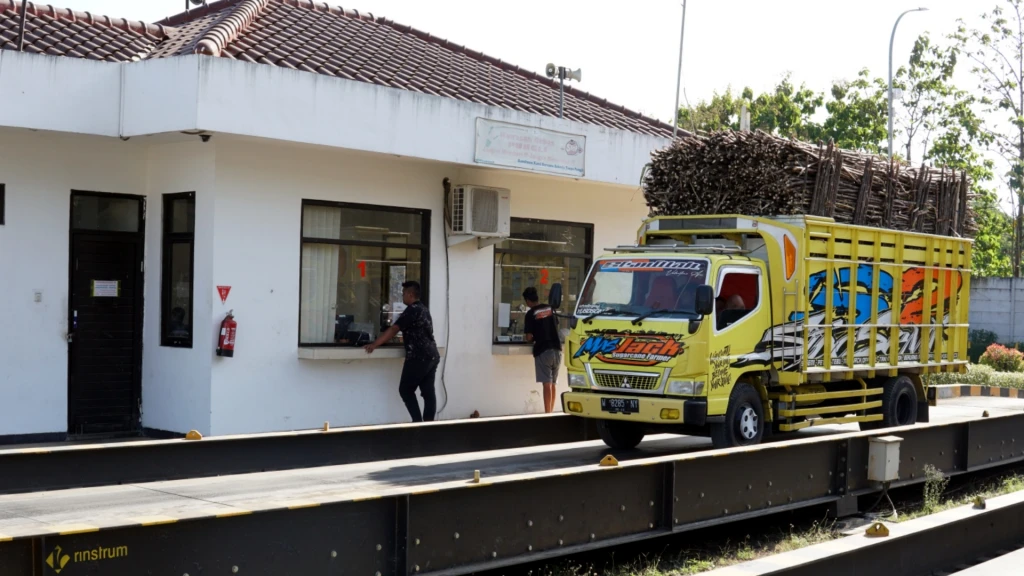Buy-and-Set System Profits Sugar Cane Farmers
Rejoso Manis Indo, 08 September 2022 | Penulis : Muhamad Devi Riswandi

The sugarcane truck passes through a digital weighing station before heading to the tipper for unloading.
Sugar Factory (PG) PT Rejoso Manis Indo (RMI) buys sugar cane from farmers with a Buy-Stop System (SBP). Many benefits can be achieved by farmers with the implementation of this system.
First, the SBP at PG RMI guarantees more certainty in the timing of payments to sugarcane farmers. Farmers do not have to wait long to get the money they sell because payments are made 2 times a week (3 days).
With the speed and timeliness of this payment, farmers can immediately allocate their funds for various things, both to finance their household needs and to finance the next sugar cane planting.
It is different if the purchase of sugar cane is done with a Profit Sharing System (SBH). Farmers can experience capital difficulties during the growing season because the proceeds from the sale of sugar cane have not been liquidated.
With SBH, it is not uncommon for new farmers to receive payments after 6 months of waiting. This problem arises because the payment is made using a sugar auction system, so the timing is uncertain. That is why PT RMI, as a small sugarcane-based sugar factory, chose not to use this method. SBH also provides a lot of room for the entry of intermediaries who have large capital to pay cash for sugarcane farmers. The intermediary's motivation is the margin or profit between the price of sugarcane paid to farmers and the money that will be received from the sugar factory. Consequently, farmers can get cash payments but at lower prices for the sake of margin for intermediaries.
Second, with the implementation of SBP, farmers who sell sugarcane to PG RMI are not charged a sack fee. Unlike the SBH system, which imposes sack fees on farmers.
Third, with SBP, the fluctuations in sugar prices have no effect on the purchase price of sugarcane farmers by PT RMI. Farmers get a clear price, even though the price of sugar changes.
Unlike the SBH which imposes costs on farmers for the fluctuations in sugar prices that occur, the SBP at PG RMI does not involve farmers at all in this matter. Sugar price fluctuations, including the risk of falling sugar prices, are fully borne by PG RMI; so that when the price of sugar is low, the price of sugar cane by farmers does not decrease. The price of sugarcane farmers remains fixed according to its quality.
Fourth, the implementation of SBP by PT RMI makes farmers do not have to bear the inefficiency of the factory. Thus, for example, there is an increase in production costs at the factory, the costs are fully the responsibility of the factory, not included as a component to reduce sugarcane prices. Likewise, for example, there is a decrease in yield because the sugarcane that has been handed over by farmers to the factory is not processed immediately, the losses that arise are not borne by the farmers.
The implementation of the SBP by PG RMI is in line with the Circular Letter (SE) of the Director General of Plantations of the Ministry of Agriculture Number 593/TI.050/E/7/2019 dated July 19, 2019 regarding the Implementation of the Sugar Cane Purchase System (SPT). This regulation was issued to support President Joko Widodo's instructions which asked the government to protect local farmers.
In this buy-out mechanism, the Purchase Price for Sugarcane Planters (HPP) is determined based on the quality of the sugarcane. This determination must be made transparently (farmers can see it directly). If the yield is 7 percent, the price of sugar cane is Rp 510 thousand per ton. If the yield is higher or less than 7 percent, the sugar cane price is adjusted proportionally.
The time of payment is also regulated in this regulation. PG must pay the farmers no later than seven days after the sugar cane is received by the factory. *
Most Popular
1
How Cane Is Processed into Sugar at PT RMI's Factory
2
The Interest of Blitar Sugarcane Farmers Continues to Increase, Here's Why
3
PT RMI and the Story of the Return of the Sugar Factory in Blitar
4
Modern Technology Behind RMI Sugar Production
5
Profitable Programs for Partner Farmers
6
Buy-and-Set System Profits Sugar Cane Farmers
7
Vacancies for you professionals in the Purchasing field
8
High Efficiency of Sugar Production in Rejoso, Blitar
9
Sugar in the Global Market
10
Blitar Regency Government and PT RMI - Mitr Phol Group Collaborate with ITS Civil Engineering Faculty Expert Team to Conduct Feasibility Test Study for Road and Bridge Classes
11
PT RMI's Environmentally Friendly Operations
12
The Ministry of Industry Appreciates PT RMI - Mitr Phol Group in Efforts to Develop the National Sugar Industry